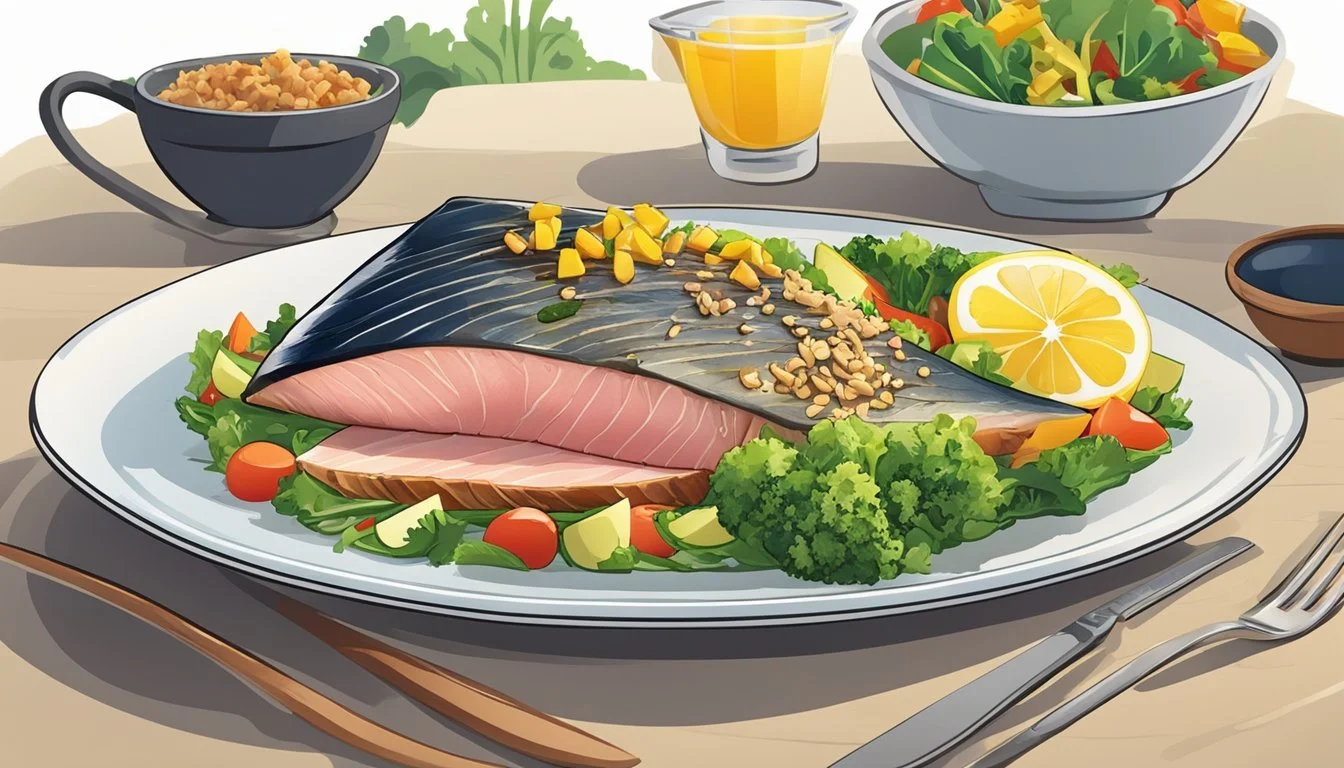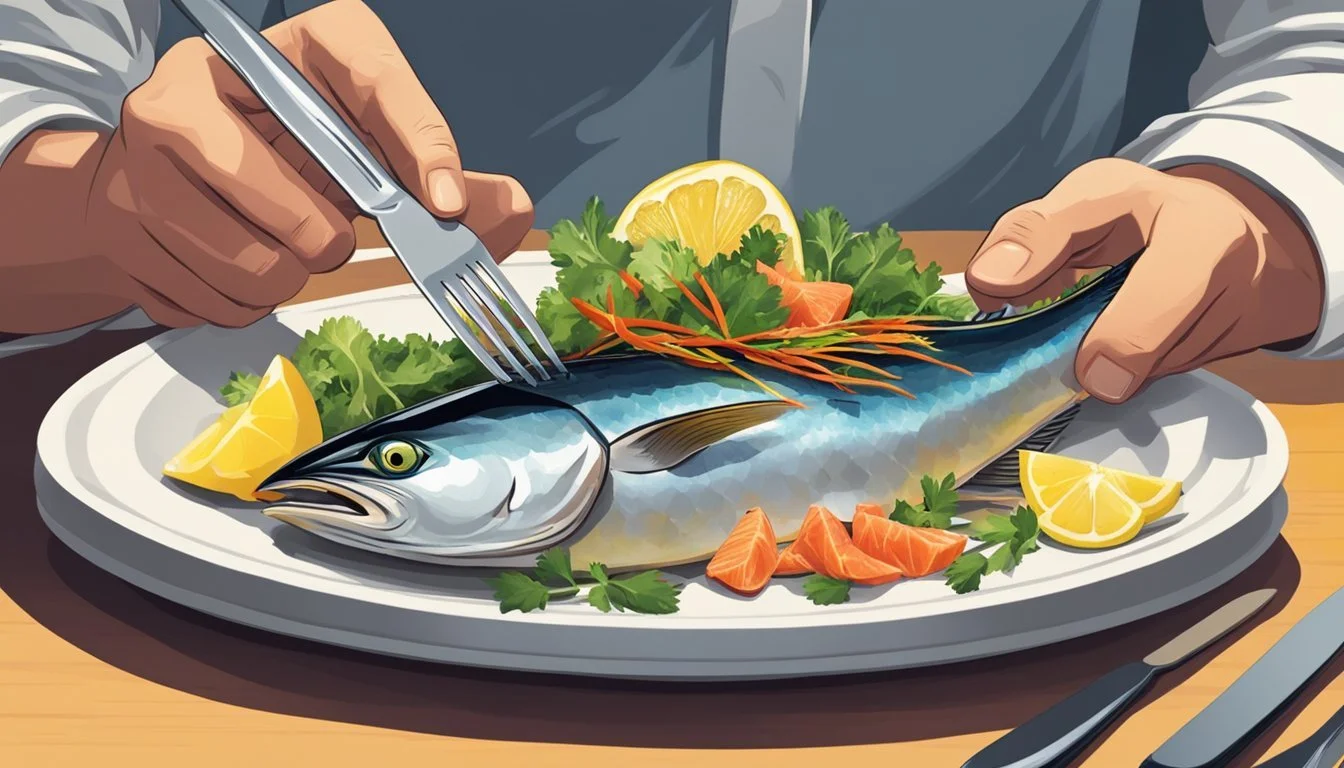How Do You Eat Yellowfin Tuna?
Expert Tips and Serving Suggestions
Yellowfin tuna (What wine goes well with tuna?) is a versatile and popular fish, enjoyed by seafood lovers around the world for its rich taste and nutritious profile. Highly regarded for its firm texture and subtly sweet flavor, it lends itself to a variety of preparation methods, allowing both home cooks and professional chefs to get creative in the kitchen. From searing and grilling to baking or enjoying it raw in sashimi form, the ways to consume yellowfin tuna are as numerous as they are delicious.
When it comes to eating yellowfin tuna, the key is to respect the quality of the fish by choosing the right cooking technique that highlights its natural flavors. While it's crucial to avoid overcooking, which can lead to dryness, some prefer to cook tuna thoroughly due to personal taste or dietary needs. In contrast, many gourmands prefer their tuna steaks (What wine goes well with tuna steak?) with a seared exterior and a rare or medium-rare center to maintain juiciness and flavor.
Yellowfin tuna also finds its place in various cuisines across the globe, reflecting local flavors and traditions. It can be marinated and seasoned with a range of spices and herbs, providing a canvas for bold and subtle flavors alike. Whether dressed up for a gourmet meal or simply prepared for a nutritious weekday dinner, yellowfin tuna offers a supreme taste experience.
Understanding Yellowfin Tuna
Yellowfin tuna is a species of tuna known for its distinctive yellow dorsal fin and high-quality meat. This fish is popular among consumers for its versatility in cooking and nutritional benefits.
Biology of Yellowfin Tuna
Yellowfin tuna (Thunnus albacares), often marketed as ahi tuna, is found in tropical and subtropical oceans worldwide. It's a pelagic species, meaning it inhabits the open sea away from the coast. The yellowfin is easily recognizable by the long, bright yellow second dorsal fin and anal fin. These fish are built for speed and endurance, with a streamlined body and capabilities of reaching considerable size, with certain individuals weighing over 400 pounds.
Nutrition Facts
Yellowfin tuna provides a rich source of protein and contains a low number of calories, making it an excellent choice for a nutritious meal. It has a lower saturated fat content, which is beneficial for maintaining heart health. Here is a brief nutritional breakdown per 3-ounce serving of cooked yellowfin tuna:
Calories: Approximately 110
Protein: Roughly 25 grams
Fat: Approximately 1 gram
Saturated Fat: Minimal
Cholesterol: Around 45 milligrams
Sodium: Variable depending on preparation
Omega-3 Fatty Acids: Especially high in EPA and DHA, contributing to its cardiovascular benefits
The fish can contain varying levels of mercury, so it is advised that individuals moderate their consumption according to dietary guidelines to avoid potential health risks. Compared to albacore tuna, yellowfin tends to have lower levels of mercury, while bluefin and bigeye tuna often have higher concentrations. It is important for consumers to differentiate between these tuna species, both for health reasons and to make informed choices related to sustainability and environmental impact.
Culinary Techniques
When it comes to preparing yellowfin tuna, there are numerous techniques that accentuate its rich flavor and firm texture. From preparing steaks to grilling, each method offers a distinct taste and presentation, appealing to a wide range of palates and dietary preferences.
Preparing Yellowfin Tuna Steaks
Preparing tuna steaks involves choosing fresh, bright-colored fish with no fishy odor. Season the steaks with salt, pepper, and your choice of herbs or spices before cooking. For an enhanced flavor, marinate the steaks in a mixture that could include ingredients like olive oil, lemon juice, garlic, and ginger.
Sushi and Sashimi
Yellowfin tuna is a favored choice for sushi (What wine goes well with sushi?) and sashimi due to its texture and taste. To serve raw, start with sushi-grade tuna to ensure it is safe to eat. Cut the tuna into thin slices against the grain and serve with soy sauce, wasabi, and pickled ginger.
Grilling Yellowfin Tuna
Grilling imparts a smoky flavor and a good sear to your tuna steak. Preheat the grill and oil the grates to prevent sticking. Cook the steaks over high heat for 4-6 minutes on each side, aiming for a medium-rare to medium doneness, which typically means a slightly pink center.
Baking Yellowfin Tuna
Baking is a healthful way to cook tuna. Preheat your oven to 450 degrees Fahrenheit, place the seasoned or marinated steaks on a baking sheet, and bake for 8-12 minutes depending on the steak's thickness. Ensure not to overbake to maintain a moist texture.
Pan Searing Yellowfin Tuna
Searing tuna steaks in a hot skillet, especially a cast iron skillet, creates a crisp exterior while keeping the inside moist. Heat a combination of oil and a small amount of butter until it's very hot, then sear the steaks for 1-2 minutes on each side. Let the steaks rest before serving to allow the juices to redistribute.
Other Cooking Methods
Beyond the common methods, yellowfin tuna can be cooked using techniques like sous vide, which yields precise doneness, or confit, where it's gently cooked in olive oil. Oil-poaching is similarly gentle and can infuse the fish with flavors from the oil and added spices. Remember to thaw appropriately if starting with frozen tuna to preserve texture and safety.
Serving Suggestions
When it comes to enjoying yellowfin tuna, selecting the right accompaniments and enhancements can turn a simple meal into a delightful culinary experience. Proper presentation elevates the dish, ensuring that both the flavors and visual appeal are given due attention.
Accompaniments
For yellowfin tuna steak, a balanced plate includes sides that complement the rich flavor of the tuna. A salad with a vinaigrette dressing offers a fresh, crisp contrast, while fried green beans provide a textural element. Sides like cucumber slices or avocado can accompany raw preparations like sushi. When serving the tuna as a poke bowl, pair it with brown rice or quinoa for a hearty and healthy base.
Grilled or Roasted Potatoes: An excellent choice for a warm, satiating side.
Rice: Either sushi rice for raw tuna or a side of aromatic jasmine or brown rice for seared or grilled steaks.
Flavor Enhancers
Yellowfin tuna's flavor is naturally rich, and it welcomes an array of seasonings and sauces. Lemon and soy sauce are classic enhancers, particularly when the yellowfin tuna is served raw or lightly seared. To create a quick marinade or topping, combine these elements:
Garlic and lemon butter sauce: Simply mix melted butter with fresh garlic and lemon juice.
Soy sauce reduction: A touch of soy sauce reduced with a bit of sugar can bring a savory umami element.
Presentation Tips
The visual presentation of yellowfin tuna should be simple yet appealing. When serving tuna steak, aim for a balanced plate with contrasting colors and textures. Consider the knife work when presenting raw tuna; clean and even slices are crucial for sushi or sashimi. For a quick and easy visual upgrade in the summer, garnish the plate with edible flowers or a sprig of fresh herbs to amplify the freshness of the dish.
Health Considerations
When consuming yellowfin tuna, one should consider both the nutritional benefits it offers and the potential health concerns related to contaminants like mercury.
Nutritional Benefits
Yellowfin tuna is a highly nutritious fish that provides a wealth of health benefits. It is a rich source of complete protein, with a 3-ounce serving containing approximately 21 grams of protein which is vital for muscle building and repair. This serving size also has a relatively low calorie count of around 93 calories, making it a suitable option for calorie-conscious diets. Yellowfin tuna contains omega-3 fatty acids, essential for heart health and known to reduce inflammation. The fish is also a source of important minerals and vitamins, including Vitamin A, Vitamin D, and Vitamin E.
Calories: 93 per 3 oz
Protein: 21 g
Total Fat: 0.42 g
Saturated Fat: 0.15 g (<1% DV)
Monounsaturated Fat: 0.10 g
Polyunsaturated Fat: 0.13 g
Omega-3 Fatty Acids: Significant
Vitamins: A, D, E
Concerns
While yellowfin tuna is undoubtedly nutritious, it contains mercury, a heavy metal that can be particularly harmful in large amounts. The concentration of mercury in tuna can vary depending on a variety of factors, including the tuna's age and size. Mercury is a neurotoxin and poses a greater risk to children and pregnant women as it can affect the development of the brain and nervous system. For most healthy adults, moderate consumption of yellowfin tuna is recommended to minimize exposure to mercury while still enjoying its nutritional benefits. It’s also important to consider the levels of sodium and cholesterol in yellowfin tuna, especially for those with dietary restrictions or specific health conditions.
Mercury: Present, caution advised
Cholesterol and Sodium: Check levels if restricted
Selection and Storage
When choosing and storing yellowfin tuna, one should prioritize freshness and proper temperature management, whether dealing with fresh or canned products. These practices ensure the fish remains flavorful and safe to eat.
Purchasing Tips
Fresh Tuna:
Look for bright red or pink flesh with no brown spots, which indicates quality and freshness.
Fresh tuna should smell like the ocean and not be overly fishy.
Verify the sell-by date to ensure the product's maximum shelf life.
Inspect the can for any signs of dents, rust, or swelling, which can indicate compromised quality.
Storing Yellowfin Tuna
Fresh Tuna:
Refrigerate immediately at temperatures below 40°F and consume within 1-2 days.
For longer storage, freeze fresh tuna by wrapping it tightly in plastic wrap, placing it in a zip-top bag, squeezing out the air, and sealing. Submerge in water to create an ice block and freeze for up to three months.
Canned Tuna:
Store in a cool, dry place and avoid exposure to extreme temperatures.
Once opened, transfer unused tuna to a sealed container and refrigerate; consume within 3-4 days to maintain quality.
Notes:
To thaw frozen tuna, one should transfer it to the refrigerator, allowing a slow thaw to maintain texture and quality.
Do not refreeze thawed tuna as this can adversely affect its taste and safety.
Recipes and Preparations
Yellowfin tuna, with its rich texture and taste, offers diverse culinary possibilities. Whether one is seeking to craft a meal quickly or create a gourmet dish, the flexibility of this seafood can cater to various tastes and occasions.
Simple Quick Recipes
For a swift and satisfying meal, simple recipes utilizing minimal ingredients are ideal. A basic approach involves:
Preheating the oven to 450 degrees Fahrenheit.
Coating the tuna lightly in olive oil, then seasoning with salt and pepper.
Placing the tuna on a baking tray and cooking for approximately 8-12 minutes, depending on thickness.
Another easy preparation is searing. This involves:
Heating olive oil in a pan over high heat.
Seasoning the tuna with salt and pepper.
Cooking each side for about 1-2 minutes to achieve a rare or medium-rare doneness.
Gourmet Tuna Creations
For those desiring to elevate their dishes, gourmet preparations employ a varied palette of flavors and garnishes. A marinated grilled yellowfin tuna recipe might include:
A marinade of lemon juice, finely chopped garlic, and onion, enriched with honey, sesame seeds, basil, and coriander.
Marinating the tuna for at least one hour to infuse the flavors before grilling.
Grilling the tuna steaks over high heat to impart a subtle smokiness, cooking each side for 4-5 minutes.
Connoisseurs can top off their gourmet creation with a butter sauce flavored with lemon and garlic, combining the zestiness of the citrus with the pungent warmth of garlic.
Cultural and Historical Context
In various cultures, yellowfin tuna plays a pivotal role, establishing itself as a prominent protein source that has seen a surge in global demand. The fish's versatility in dishes has significantly shaped culinary traditions across the world.
Yellowfin Tuna in Different Cuisines
Yellowfin tuna, often referred to as ahi, is a cornerstone of Japanese and Hawaiian cuisines. In Japan, it's a prized ingredient in sushi and sashimi—delicacies where the fish's flavor and texture are celebrated. Hawaiian poke bowls utilize raw yellowfin tuna as a central element, often seasoned with soy sauce and sesame oil, highlighting the cultural significance of the fish in the region.
Within the Mediterranean gastronomy, yellowfin tuna has traditionally been consumed grilled or baked. They season the fish with local herbs and spices, revealing the food's cultural adaptability. In contemporary Western cuisines, yellowfin tuna steaks have become a popular seafood choice, usually served seared and paired with various sides.
The Rise of Tuna Popularity
The popularity of yellowfin tuna has escalated with the global expansion of Japanese food (What wine goes well with Japanese food?) culture. Sushi bars and Japanese restaurants have played a key role in introducing ahi tuna to a broader international audience. As sushi became a global trend, the demand for high-quality fish like yellowfin tuna grew.
Health trends have also influenced the fish's popularity, as consumers increasingly seek out protein-rich and low-fat food options. The inclusion of yellowfin tuna in diets is endorsed for its Omega-3 content and perceived health benefits, making it a favorite in health-conscious meals like salads and grain bowls.
Conservation and Ethics
When eating yellowfin tuna, it is crucial to consider both the conservation of this species and the ethical implications of its consumption. Sustainable fishing practices ensure healthy populations, while ethical considerations address the consumer's role in demand and environmental impact.
Sustainable Fishing Practices
Sustainable fishing of yellowfin tuna involves adhering to regulations that prevent overfishing and ensuring fish populations remain healthy for future generations. International guidelines suggest:
Selective fishing gear: Using methods that reduce bycatch of non-target species and juveniles.
Quotas: Adhering to catch limits based on scientific assessments to avoid depleting tuna stocks.
Ethical sourcing can be confirmed through certifications such as the Marine Stewardship Council, which indicates the fishery's operations align with ongoing preservation efforts.
Ethical Considerations
Consumers play a vital role in supporting sustainable fisheries. They should:
Research before purchasing: Identify if the yellowfin tuna is sourced from a fishery that employs sustainable practices.
Make informed decisions about frequency of consumption due to concerns like mercury accumulation in larger fish.
Ethically eating yellowfin tuna also involves culinary practices such as avoiding overcooking to respect the quality of the fish, ensuring that the consumption is worthwhile and minimizes waste. It is deemed safe to eat when sourced and prepared responsibly.
Frequently Asked Questions
In this section, readers will find pertinent information related to common inquiries about yellowfin tuna, also known as ahi tuna. From identifying freshness to cooking techniques, these FAQs aim to enhance your understanding and enjoyment of this popular fish.
How to Tell if Yellowfin Tuna is Fresh
To determine the freshness of yellowfin tuna, inspect the color and smell. Fresh tuna will have a bright red or pink hue with a shiny appearance. Any dullness or brown spots can indicate age. The fish should smell oceanic; any strong fishy or ammonia-like odors suggest it's past its prime.
Can You Eat Yellowfin Tuna Raw?
Yellowfin tuna, often referred to as ahi tuna, is commonly consumed raw and is a staple in dishes such as sushi and sashimi. When eating raw, one must ensure that the fish is labeled as "sushi-grade" or "sashimi-grade," denoting that it has been frozen at temperatures that kill parasites, making it safe to eat.
What are Common Mistakes When Cooking Yellowfin Tuna?
When cooking yellowfin tuna, a frequent mistake is overcooking, which can result in a dry, less flavorful steak. Ideally, it should be cooked briefly over high heat to just sear the outside, leaving the inside moist and pink. Another misstep is neglecting to marinate or season the fish, which can enhance its natural flavors.
How Does Yellowfin Tuna Compare to Other Types?
Yellowfin tuna (ahi) typically has a milder taste and a firmer texture compared to albacore tuna. It's less fatty than bluefin but more so than albacore, resulting in a balance of flavor that's preferred by many. Bigeye tuna is similar to yellowfin but is generally found in deeper, cooler waters and can taste slightly richer.






